Productivity analysis and efficiency of concrete casting using mini-cranes with a capacity of 200 kg based on appropriate technology
DOI:
https://doi.org/10.7764/rdlc.19.2.198-208Keywords:
Mini-crane, Productivity, Efficiency, Appropriate TechnologyAbstract
The main objective of this study was to analyze the productivity and efficiency of concrete casting using a mini crane with a capacity of 200 kg as designed by the researcher, compared to using the manual method. The method used in this study is the assembly of mini cranes with a capacity of 200 kg, then field or work tests are carried out and accompanied by observations and subsequent data analysis. The results obtained in this study are that the engine from motorcycle waste can lift loads up to 100 kg even though its ability can lift 200 kg, working for 10 hours only consumes 3 liters of gasoline. The results of the analysis are that using a mini-crane is more profitable compared to the manual method. The authenticity of this research is that mini-cranes are designed and made by researchers with style and models adapted to the conditions of small towns and inland areas in Indonesia, made based on Appropriate Technology not using imported materials and prioritizing scrap metal waste which is the authenticity of this research , thus our research has the principle of producing innovations and works that are useful for human life.
Downloads
Downloads
Published
How to Cite
Issue
Section
License
Copyright (c) 2020 Sunaryo Cim

This work is licensed under a Creative Commons Attribution-NonCommercial-NoDerivatives 4.0 International License.








